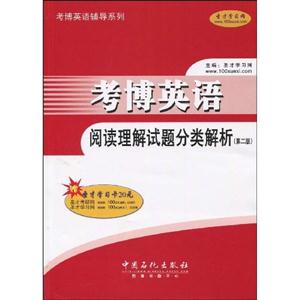包郵 考博英語(yǔ)閱讀理解試題分類解析-(第二版)-贈(zèng)圣才學(xué)習(xí)卡20元
-
>
2021年國(guó)家統(tǒng)一法律職業(yè)資格考試案例分析指導(dǎo)用書(全2冊(cè))
-
>
新東方(2021)十天搞定考研詞匯(便攜版)
-
>
安全生產(chǎn)管理 2019版中級(jí)
-
>
馬克思主義基本原理概論 自學(xué)考試學(xué)習(xí)讀本 (2018年版)
-
>
中國(guó)近現(xiàn)代史綱要自學(xué)考試學(xué)習(xí)讀本(2018年版)
-
>
長(zhǎng)篇小說(shuō):格列佛游記
-
>
普通話水平測(cè)試專用教材
考博英語(yǔ)閱讀理解試題分類解析-(第二版)-贈(zèng)圣才學(xué)習(xí)卡20元 版權(quán)信息
- ISBN:9787511400840
- 條形碼:9787511400840 ; 978-7-5114-0084-0
- 裝幀:暫無(wú)
- 冊(cè)數(shù):暫無(wú)
- 重量:暫無(wú)
- 所屬分類:>>
考博英語(yǔ)閱讀理解試題分類解析-(第二版)-贈(zèng)圣才學(xué)習(xí)卡20元 本書特色
《考博英語(yǔ)閱讀理解試題分類解析(第2版)》:圣才學(xué)習(xí)卡,學(xué)習(xí)一卡通,百種考試名師面授,千種科目網(wǎng)上輔導(dǎo)。提供名師網(wǎng)絡(luò)課程 贈(zèng)送圣才學(xué)習(xí)卡中華英語(yǔ)學(xué)習(xí)網(wǎng)(www.100yingyu.com)提供名師網(wǎng)絡(luò)課程;隨書贈(zèng)送的圣才學(xué)習(xí)卡在圣才學(xué)習(xí)網(wǎng)旗下48個(gè)網(wǎng)站上可免費(fèi)下載20元的名校考研真題和其他復(fù)習(xí)資料(歷年真題、筆記講義、在線測(cè)試等)。學(xué)習(xí)名師網(wǎng)絡(luò)課程及下載英語(yǔ)類考試歷年真題等相關(guān)資料可以通過(guò)以下具體途徑:登錄圣才學(xué)習(xí)網(wǎng)(www.100xuexi.com)進(jìn)入中華英語(yǔ)學(xué)習(xí)網(wǎng),或者直接登錄中華英語(yǔ)學(xué)習(xí)網(wǎng)。
考博英語(yǔ)閱讀理解試題分類解析-(第二版)-贈(zèng)圣才學(xué)習(xí)卡20元 目錄
考博英語(yǔ)閱讀理解試題分類解析-(第二版)-贈(zèng)圣才學(xué)習(xí)卡20元 節(jié)選
《考博英語(yǔ)閱讀理解試題分類解析(第2版)》是一本旨在提高考生考博英語(yǔ)閱讀理解水平的復(fù)習(xí)資料。它從眾多名校近幾年考博英語(yǔ)閱讀理解試題中精選出具有一定難度的100多篇文章,按常考的閱讀理解主題(科普科研、文化教育、經(jīng)濟(jì)管理等)分為12大類,幾乎涉及到在考博試題中常考的各類題材。每篇文章均有詳細(xì)解析和題海拾貝,解析部分為考生指明了答題思路,題海拾貝部分歸納了文中的重點(diǎn)、難點(diǎn)單詞及詞組,其中包含一些專業(yè)詞匯,便于考生拓寬自己的知識(shí)領(lǐng)域及擴(kuò)大相關(guān)領(lǐng)域的詞匯量,針對(duì)性較強(qiáng)。對(duì)于近幾年考博英語(yǔ)閱讀理解的真實(shí)水平及選材的趨勢(shì),《考博英語(yǔ)閱讀理解試題分類解析(第2版)》具有很強(qiáng)的代表性和說(shuō)服力。圣才學(xué)習(xí)網(wǎng)/中華英語(yǔ)學(xué)習(xí)網(wǎng)(www.100yingyu.com)提供英語(yǔ)語(yǔ)類考試名師網(wǎng)絡(luò)班及面授班(隨書配有圣才學(xué)習(xí)卡,網(wǎng)絡(luò)班及面授班的詳細(xì)介紹參見《考博英語(yǔ)閱讀理解試題分類解析(第2版)》*后內(nèi)頁(yè))。《考博英語(yǔ)閱讀理解試題分類解析(第2版)》和配套網(wǎng)絡(luò)班及面授班特別適用于參加博士研究生入學(xué)考試的考生,也適用于考研英語(yǔ)、職稱英語(yǔ)、博士學(xué)位英語(yǔ)等其他考試的考生參考。
考博英語(yǔ)閱讀理解試題分類解析-(第二版)-贈(zèng)圣才學(xué)習(xí)卡20元 相關(guān)資料
Whenever two or more unusual traits or situations are found in the same place, it is tempting to look for more than a coincidental relationship between them. The high Himalayas and the Tibetan plateau certainly have extraordinary physical characteristics and the cultures which are found there are also unusual, though not unique. However, there is no intention of adopting Montesquieu' s view of climate and soil as cultural determinants. The ecology of a region merely poses some of the problems faced by the inhabitants of the region, and while the problems facing a culture are iinportant to its development, they do not determine it.The appearance of the Himalayas during the late Tertiary Period and the accompanying further raising of the previously established rages had a marked effect on the climate of the region. Primarily, of course, it blocked the Indian monsoon(季風(fēng)) from reaching Central Asia at all. Secondarily, air and moisture from other directions were also reduced.Prior to the raising of the Himalayas, the land now forming the Tibetan uplands had a dry, continental climate with vegetation and animal life similar to that of much of the rest of the region on the same parallel, but somewhat different than that of the areas farther north, which were already drier. With the coming of the Himalayas and the relatively sudden drying out of the region, there was a severe thinning out of the animal and plant population. The ensuing incomplete Pleistocene glaciations (冰蝕) had a further thinning effect, but significantly did not wipe out life in the area. Thus after the end of the glaciation there were only a few varieties of life extant from the original continental species. Isolated by the Kunlun range from the Tarim basin and Turfan depression, species which had already adapted to the dry steppe climate, and would otherwise have been expected to flourish in Tibetan, the remaining native fauna and flora (動(dòng)植物)multiplied. Armand describes the Tibetan
- >
朝聞道
- >
莉莉和章魚
- >
名家?guī)阕x魯迅:故事新編
- >
推拿
- >
山海經(jīng)
- >
煙與鏡
- >
詩(shī)經(jīng)-先民的歌唱
- >
我與地壇















